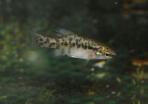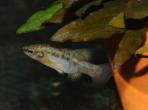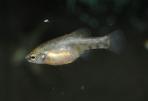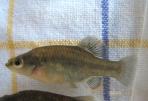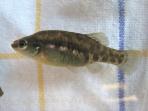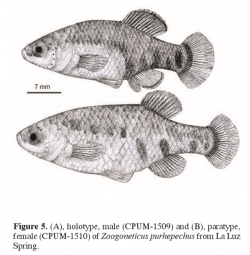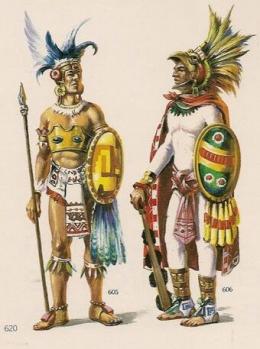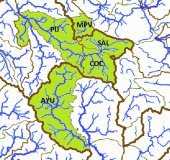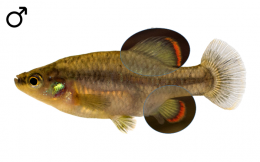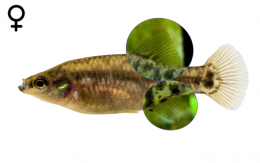Zoogoneticus purhepechus
DOMÍNGUEZ-DOMÌNGUEZ, O., PÉREZ-RODRÍGUEZ, R. & I. DOADRIO (2008): Morphological and genetic comparative analyses of populations of Zoogoneticus quitzeoensis (Cyprinodontiformes: Goodeidae) from Central Mexico, with description of a new species. Revista Mexicana de Biodiversidad 79: pp 373-383
Collection-number: Colección de Peces de la Universidad Michoacana, Cat. No. CPUM-1509.
The Holotype is a mature male of 34.12mm standard length, collected by L. Couvreur, J. de Moree, K. de Jong, J. C. Merino and L. Escalera-Vázquez in November 2002. Together with the Holotype were collected 28 Paratypes of both sexes and placed at several institutes (Cat. No's. CPUM-1055, MNCM-246184, CNP-IBUNAM-14425-14427).
The left picture shows a drawing of the Holotype and a Paratype of Zoogoneticus purhepechus, the right one a painting of two Tarascan soldiers. The species was named after this people, the Tarascan or Purepecha:
The Holotype was collected in a spring fed pond called La Luz (other name: Presa Verduzco) from the Río Duero drainage, lower Río Lerma system, Zamora de Hidalgo, Michoacán.
This species is named for the indigenous ethnic group "Purhepecha" that lives in a part of the distribution range of this species, including the type locality. This people was very powerful in former times, but lives in the shadow nowadays. It was called "Michihuáquè" in Náhuatl, which means: those, who have fish. The name Michoacán for the federal state has the same origin and means: land of those who have fish (michin = fish; hua = owner; can = land)
The genus Zoogoneticus was erected by Meek in 1902 with quitzeoensis as type species with reference to the fact that this genus encompasses livebearing fish. The generic name can be derived from the ancient Greek with ζῷον (zóon) meaning animal, γόνος" (gónos) offspring and νέμω (néon) in the sense of distributing. The Latin suffix -ticus forms a noun from an adjective, so the name of the genus means something like "baby distributor".
Platypoecilus quitzeoensis Bean, 1898 (partially)
Poecilia quitzeoensis Meek, 1902 (partially)
Zoogoneticus quitzeoensis Meek, 1902 (partially)
The Tarascan Splitfin is endemic to the Mexican federal states of Jalisco and Michoacán. It historically occured in the Lower Río Lerma drainage including this river itself and several affluents like the Río Duero, then the Laguna Chapala and adjacent sections of the Río Grande de Santiago including some affluents until about Guadalajara. Furthermore it inhabited the endorheic lagoons W of the Chapala lake, means the lagunas Atotonilco, San Marcos, Zacoalco, and de Sayula, the upper Río Ameca drainage and finally the endorheic Laguna Magdalena basin. The species disappeared from Río Grande de Santiago, from most of the known places in the endorheic lagoon areas and from most of the habitats within the Río Ameca drainage. The large distribution area and different populated drainages are the reason for distinguishing six subpopulations of this Splitfin: The Lower Río Lerma subpopulation (type subpopulation) including the Río Duero, the Laguna Chapala/ Río Grande de Santiago subpopulation, the Laguna Magdalena subpopulation, the Upper Río Ameca subpopulation, the Laguna de Sayula subpopulation, and the Laguna San Marcos subpopulation, including the lagunas San Marcos, Zacoalcos and Atotonilco. The bold names are the ones officially used by the Instituto Nacional de Estadística y Geografía; nevertheless, other ones might be more often in use or better known and therefore prefered.
ESU ist short for Evolutionarily Significant Unit. Each unit expresses an isolated population with different genetic characteristics within one species. ESU's can be defined by Molecular genetics, Morphology and/or Zoogeography and help in indicating different phylogenetic lineages within a species. The abbreviation for an ESU is composed of three letters of the genus, followed by the first two letters of the species name and an ongoing number in each species.
In Zoogoneticus purhepechus, Molecular genetics give us the possibility to distinguish three ESU's (reference: Domínguez-Domínguez et al., 2008 and unpublished data): The first unit - Zoopu1 - encompasses populations of the Río Lerma basin, means from the Laguna Los Negritos (La Alberca), the lagos Chapala, Jaripo, La Plantanera and Camécuaro, the springs and presas La Luz, Cupatziro and Orandino and the ríos Celio, Jaripo and Duero. This ESU has to be threated as endangered. The second unit - Zoopu2 - is distributed west of Zoopu1, especially in the ríos Ameca, Veneros, the manantial Almoloya, the Lago Magdalena and finally in the Rio Teuchitlán. The same status goes with this ESU: Endangered. The third and last ESU, Zoopu3 is distributed in the Sayula valley: Tanque El Molino at Cuyacapán. It was thought to be extinct, was rediscovered on a survey of the GWG n 2016, but disappeared again in 2018. The status for this population is Critically endangered.
The left map shows the Río Santiago-Aguamilpa (SA), Rio Santiago-Guadalajara (SG), Río Lerma-Chapala (LC) and Lago de Chapala (CH) basins from the Hydrographic Region Lerma-Santiago, and the Presa La Vega-Cocula (VC) and Río Ameca-Atenguillo (AA) basins from the Hydrographic Region Ameca on a Mexico map. The middle map shows the occurence of this species in its eastern distribution area including the type locality in the Río Duero subbasin (DUE) and three more subbasins of the Río Lerma-Chapala basin: the ríos Angulo-Río Briseñas (ABR) and Briseñas-Laguna Chapala (BRI) and the Arroyo Huascato (HUA) subbasin. It can also be found in the Río Sahuayo (SAH) and Laguna Chapala (CHA) subbasins, in adjacent subbasins in the west, the lagunas de San Marcos (LSM) and de Sayula subbasins (SAY), and north, the Laguna Chapala-Río Corona (COR), Río Corona-Río Verde (CVE) and Río La Laja (LAL) subbasins. The right map shows western habitats of this species in the ríos Salado (SAL), Cocula (COC), Ameca-Pijinto (PIJ), Ayuquila (AYU) and Laguna Magdalena-Laguna Palo Verde (MPV) subbasins. The one from the Río Ayuquila is probably not autochthonous:
International Union for Conservation of Nature (IUCN): Vulnerable
Distribution and current conservation status of the Mexican Goodeidae (Lyons et al., 2019): Vulnerable/declining: „This species was recently separated from Z. quitzeoensis based on genetic and morphological differences (Domínguez-Domínguez et al., 2007, 2008). The historical range of this species, as currently defined, encompassed the lower Lerma, upper Santiago (including Lake Chapala), upper Ameca, and upper Armería river basins on the Pacific slope, and the endorheic Lake Magdalena, Atotonilco, San Marcos, and Sayula basins in westcentral Mexico (Miller et al., 2005; Domínguez-Domínguez et al., 2008). Lake drying, water pollution, and introductions of non-native species have eliminated Z. purhepechus from many areas. We recognize three ESUs based on genetics and zoogeography. Zoopu1 is vulnerable and occurs in the upper Santiago and lower Lerma River basins including Lake Chapala. It has become scarce in Lake Chapala due to non-native species and has disappeared from much of the Santiago and Lerma basins owing to water pollution and habitat destruction. The best remaining populations occur in four springs that drain to the Duero River, a tributary of the Lerma River (Lyons et al., 1998; Soto-Galera et al., 1998; Moncayo-Estrada et al., 2015). Zoopu2 is endangered and is known from the Upper Ameca River basin and the endorheic Lago Magdalena basin. Once moderately common, it is now rare at one location in the Magdalena basin and occurs at only one or two locations in the Ameca basin, declining because of water pollution, habitat loss, and non-native species. Zoopu3 is critically endangered and known historically from the Armería River and Atotonilco and San Marcos lake basins. Habitat destruction, water diversions, water pollution, and non-native species have eliminated this ESU from the Armería and Atotonilco basins, and it persists in very small numbers at one site in the San Marcos basin (Lyons et al., 1998; DomínguezDomínguez et al., 2008; Domínguez unpublished data).“
NOM-059-SEMARNAT-2010: no categoría de riesgo (no category of risk)
Zoogoneticus purhepechus can be found in lakes, streams, ponds, canals and ditches over substrates of clay, silt, mud, sand, gravel, decayed organic matter and rocks. It prefers clear to muddy water with currents none to moderate and can be seen in depths of less than 1m, usually less than 0.6m, pefering areas with dense vegetation including green algae, Eichhornia, Scirpus, Potamogeton, Nasturtium, Chara and Lemna.
On surveys of the GWG to the Río Duero drainage in 2014, 2016 and 2018, the species was found in dense root mesh of riparian trees in La Luz spring (Salix sp.)and Camécuaro lake (Taxodium sp.). In the Sayula lagoon basin, it was rediscovered in 2016 in a small muddy pond where it was gone in November 2018, when the habitat was surveyed again. It occured in 2016 in small numbers in the Río Teuchitlán headwaters where it was seen individual or pairwise looking for food between isolated rocks, on a spring on a private property in La Estancia de Ayones and in an irrigation channel from the Magdalena lake. It was found in good numbers in dense riparian vegetation in Almolya and in low numbers in hauls of fishermen from the Chapala lake in January 2019.
Underwater-Videos:
Captures of young from the closely related Zoogoneticus quitzeoensis indicate a reproduction period from January to April. Kingston (1979) noted pregnant females and fish in all sizes of Zoogoneticus purhepechus in April at the Lago de Camécuaro in Jalisco. On survey of the GWG to the Río Duero drainage in November 2014, different stages of juvenile fish as well as adult fish and even gravid females were seen.
The teeth are conical and the gut is short. Combined with a small pointed mouth, this species is definitely a visiual predator, picking up small invertebrates like crustaceans and insect larvae.
Both sexes exhibit a light brown colouration, with dark brown and moderately large spots on the posterior part of the body, starting at the base of the caudal fin. In the anterior part of the body, a mottling pattern of small spots can be distinguished at the top of the ventral region. They show a pair of dark brown spots laterally aligned at the base of the caudal peduncle, in the region of the hypural plate. In males, during the breeding season, these spots could not be distinguished. The ventral region lacks spots. Adult males are slightly darker than females and may show a slightly bluish or greenish hue on the lateral side of the body and some scales can produce iridescence. The males from the type locality show an intense red band at the end of the pelvic and dorsal fins. In specimens from other localities, this band may be an intense orange.
Males and females of the Tarascan Splitfin are easy to distinguish. The safest characteristic is the Splitfin in males, means the for Goodeinae typical mating organ formed by a notch after the first seven shortened rays of the Anal fin. Additionally, males typically have an orange to red terminal band on dorsal and anal fins while females display clear fins. Males are at least during courthsip more beautifully coloured while females keep their abdominal blotches, but this is not a safe character.
Although this species is widely distributed in different drainages along the occidental part of Central México, there has been observed a reduction in its distribution of almost 75% of the historical occurence points (Domínguez 2008). The most common alterations are the introduction of exotic species, dessication and water pollution. Following Domínguez, this species is in threat of being extinct.
In 2011, L. Boto, O. Domínguez and I. Doadrio studied the relationship within Zoogoneticus purhepechus. The results suggest a very close kin relation for the populations from the lower Río Lerma basin and Lake Chapala area on one hand, and for the populations from the upper Río Armería and lakes Moloya and Magdalena on the other. This genetic differences find expression in 2 clear defined lineages within this species.
Optically, the two species quitzeoensis and purhepechus are hardly to distinguish. The main morphological difference is the longer dorsal fin of purhepechus (13 or 14 rays to 11 till 13 in quitzeoensis), and thereof resulting divergent distances from snout to dorsal fin and dorsal fin to caudal fin. Genetically, the differences in the cytochrome b gene range between 3 and 3.8%, which is a higher value than it can be found between some other species (0.6 - 1.7% between Skiffia francesae and multipunctata e.g.) - and even more than between man and chimpanzee regarding the same gene (3%), so both species are well defined and the results are statistically strong supported.
Looking on the biotopes of Zoogoneticus purhepechus, they suggest the species may prefer dense vegetation and roots to hide. In the wild, there was little or none current to observe in the biotops of these species, so it won't be necessary in the aquarium as well. In the aquarium, the fish often hide deep in the shelter, but courting or impressing as well as fighting males can often be seen in the open water. Fry is rarely eaten, but it may depend on the quantity and quality of food and on the number of space to hide. When several different stages of juveniles occur, fry is usually neglected, so it makes sense to add separate brought up fry to the group with a size of 1.5 or 2cm to provide these stages and get a flock breeding colony.
The recommended tank size is at least 80 liters, bigger ones are better for sure. Dense vegetation combined with many roots and wood and free space areas for the males to impose and fight make sense. The current should be moderate, especially as the oxygene level should be quite high (at least 8mg/l) for this spring inhabiting species.
In the wild, the species feeds mainly from small or middle-sized invertebrates like bloodworms or insect larvae, so feeding with similar food, water fleas, Mysids and other food from animalistic sources will be best for this predatory fish. The related Zoogoneticus quitzeoensis was observed at la Mintzita spring looking for small sources of food between rocks and picking up small Copepods or organic matter. In aquarium, it feeds also well from flake food, granulate and even tablets, additionally given Nauplia of Brine Shrimps are eaten greedy. The species is anything else but shy.
Concerning water quality, this species is in need of bigger water changes (60-80% every week) like most of the Goodeids, especially river and spring inhabiting species, so an automatic water changing system can be helpful. Otherwise, in combination with constant temperatures higher than 24°C, fish may get sick, lose resistance against diseases and age too fast. So for keeping the strain healthy and strong, give the fish a rest during winter time with temperatures lower than 20°C for 2 or 3 months so they stop producing fry. In spring, when the temperature slowly increases, they will start spawning at 20 or 21°C and won't stop until it gets colder again or gets too warm (25°C).
This species is doing very well when is kept in the open from spring to fall, starting when the water temperature by day exceeds 17°C and cold periods are no longer expected. Bring them out in the early afternoon, the time of the day with the highest water temperature. During the warm summer, reproduction will stop and may occur again in fall. Bring the fish in before the water temperature deceeds 17°C by day and keep them cool for the first days, then slowly raise the temperature but try to stay below 20°C over the winter time.
Here each species are assigned populations of fish in husbandry and in brackets aliases of these locations to assist in identifying own stocks. Each population is assigned a unique Population-ID, composed by the ESU, the subbasin where this population is occurring (three capital letters) and a unique location identifier.
Populations in holding:
1. Zoopu1-COR-EFue
Population: El Fuerte
Hydrographic region: Lerma-Santiago
Basin: Río Santiago-Guadalajara
Subbasin: Laguna Chapala-Río Corona
Locality: a ditch to the Chapala lake at El Fuerte near Ocotlán
2. Zoopu1-CHA-LCha
Population: Lago de Chapala (aka Laguna Chapala)
Hydrographic region: Lerma-Santiago
Basin: Laguna Chapala
Subbasin: Laguna Chapala
Locality: Laguna Chapala, at Jocotepec
3. Zoopu1-DUE-LLuz
Population: La Luz (aka Presa de Verduzco)
Hydrographic region: Lerma-Santiago
Basin: Río Lerma-Chapala
Subbasin: Río Duero
Locality: Presa de Verduzco, E of Jacona de Plancarte
4. Zoopu1-DUE-RNue
Population: Rancho Nuevo (erronously distribution as Laguna Magdalena, Magdalena channel)
Hydrographic region: Lerma-Santiago
Basin: Río Lerma-Chapala
Subbasin: Río Duero
Locality: channel near a new farmhouse about 5km NW of Jacona de Plancarte
5. Zoopu2-SAL-RTeu
Population: Río Teuchitlán (aka Teuchitlán, El Rincón)
Hydrographic region: Ameca
Basin: Presa La Vega-Cocula
Subbasin: Río Salado
Locality: RíoTeuchitlán, spring area of El Rincón
6. Zoopu3-SAY-Say
Population: Sayula (aka Tanque el Molino de Cuyacapán, Cuyacapán spring, Cuyacapán)
Hydrographic region: Lerma-Santiago
Basin: Laguna Chapala
Subbasin: Laguna de Sayula
Locality: small pond at the old mill of Cuyacapán, S of Cuyacapán, about 400m S of the Agua Azul spring







